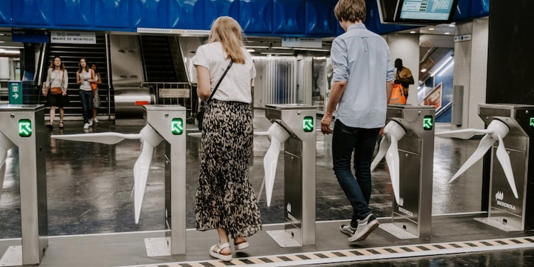A green energy pilot project at the Miromesnil Metro Station in Paris, France has involved the installation of six turnstiles that serve as miniature turbines capturing the kinetic energy produced by people as they pass through them. The technology being used here comes from Bilbao, Spain-based Iberdrola, a multinational electricity utility company.
Wind and hydroelectric power are two examples of commonly used kinetic energy sources. What else is there? Gravity combined with large drops can be a kinetic energy source. Back in February 2023, I wrote about using the vertical drop found in abandoned mine shafts where large payloads of material like sand or gravel could be dropped to power turbines and generators.
Another kinetic energy source that we can harvest comes from our feet on sidewalks and floors and from cars and trucks we drive on roads.
Speaking of feet, our shoes can become portable power generators with piezoelectric devices in the soles and heels producing enough electricity to power mobile devices.
As cars and trucks drive over roadways embedded with piezoelectric harvesters, the conversion of small amounts of mechanical surface force can be turned into electricity.
The floors in our homes and workplaces can become kinetic energy harvesters.
Imagine a crowd going into a sporting event and as they walk to and through the stadium, they generate enough force to power the stadium lights, or electricity that can be put into battery storage for later use.
So why aren’t we harvesting the kinetic energy we produce from daily activities?
The Paris Metro station pilot project is worth noting. Turning a turnstile into a power source is a neat idea. At the Miromesnil station, 27,000 people pass through those turnstiles every day. Iberdrola has estimated that if all the Paris Metro stations were to convert to turnstile turbines the subway would generate 136 Megawatts annually, almost enough energy to power the entire Metro system and equivalent to removing 30,000 tons of CO2 from the atmosphere annually.
The retrofit of the Paris Metro, however, is not happening because the powers that be have concluded that the cost of converting the entire system to turnstile turbines would be too expensive. Iberdrola, however, believes that the technology has a future and is looking to other cities to deploy turnstile turbines.
In 2012, Innowattech, an Israeli company, proposed putting piezoelectric harvesters in roadways noting that one kilometre (0.62 miles) would produce 400 Kilowatts of power, enough to light and heat over 160 homes.
A 2018 UC Berkeley study looked at the per-kilometre cost of installing piezoelectric harvesters in roads at $1 million. The Interstate Highway System in the United States is 78,465 kilometres in length based on 2020 data. To convert the Interstate to become a kinetic energy source would exceed $80 billion. The harvested piezoelectric energy from two lanes with embedded piezoelectric harvesters would produce more than 31.3 million Kilowatts. That would be equal to the energy requirements of 27,000 U.S. homes monthly. Taking the average CO2 emissions produced by American homes at 40 tons per year, the power harvested from Interstate drivers would remove over 1 million tons of CO2 annually.
Staying the course in how we produce the electricity we consume today is cheaper per Kilowatt than these novel kinetic technologies at present. Nevertheless, kinetic energy alternatives such as the turnstile turbines in Paris and the piezoelectric-implanted roads and walkways in the UC Berkeley study, if scaled, would offer zero-emission-generated electricity at a comparable cost.
The Paris Metro’s turnstile turbine technology is a good thing. We need a lot more of these novel technologies and the political and business acumen to make our future one where the energy we consume doesn’t end up compromising the environment we bequeath to future generations.
In pursuit of mitigating climate change caused by our modern industrialized world, not putting research and funding into these types of energy sources is in my opinion a mistake.










Your article, advocating turn-style turbines, has multiple issues. The amounts of energy generated are tiny (less than one small commercial wind turbine), and they get the units wrong (a stock of energy is measured in Megawatt HOURs, a flow is measured in Megawatts).
The writer needs to read a physics textbook, then come back to do some proper energy reporting.
I am not advocating turnstile turbines. The article explored different approaches to harvesting kinetic energy from human activity. I often am challenged by how to report Kilowatts versus Kilowatt/hours. I’m not a physicist but would be happy to receive an explanation on the terms and when to use them properly.